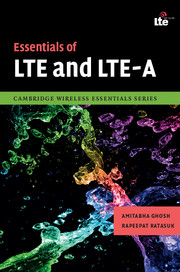Book contents
2 - LTE overview
Published online by Cambridge University Press: 05 August 2011
Summary
Introduction
Long Term Evolution (LTE) of the Universal Mobile Telecommunications System (UMTS) was developed to ensure that the technology remains competitive for the foreseeable future. Requirements for the LTE Rel-8 system include improved system capacity and coverage, improved user experience through higher data rates and reduced latency, reduced deployment and operating costs, and seamless integration with existing systems. The requirements may be broken down into different categories – system performance, latency, coverage, deployment, and complexity. To achieve these goals, new designs for the radio access networks and system architectures are needed.
- Type
- Chapter
- Information
- Essentials of LTE and LTE-A , pp. 10 - 32Publisher: Cambridge University PressPrint publication year: 2011
References
- 3
- Cited by



